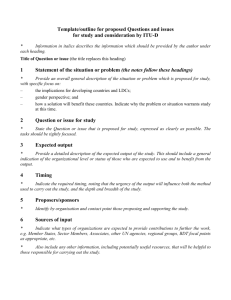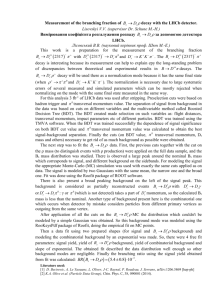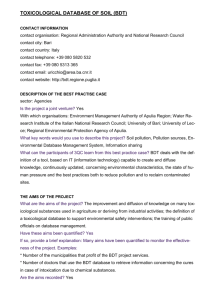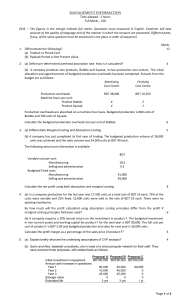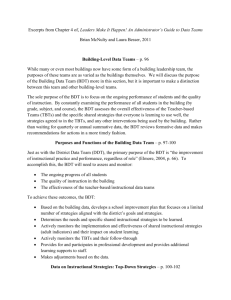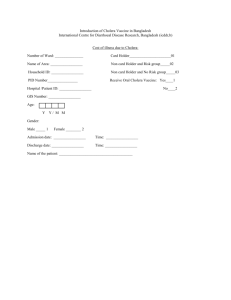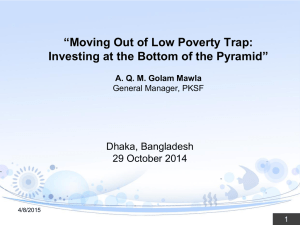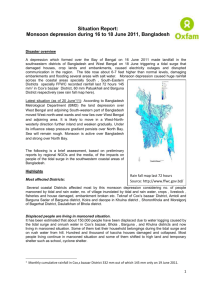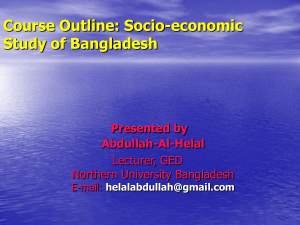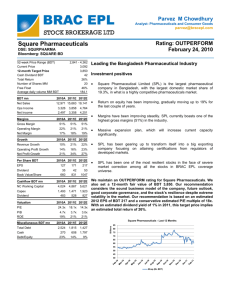1 Bangladesh
advertisement
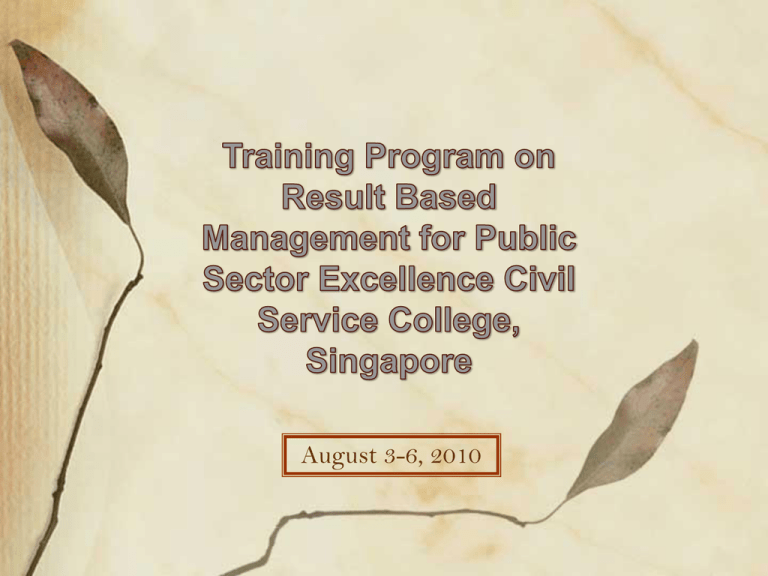
August 3-6, 2010 Government of the People’s Republic of Bangladesh Ministry of Education www.moedu.gov.bd Bangladesh Bangladesh Facts and Figures History 4th century B.C.: Recorded history traceable with clear evidence of flourishing civilization consisting of cities, palaces, temples, forts, seats of learning and monasteries; 12th century A.D.: advent of the Muslims, enjoying periods of prosperity under Muslim rule; 17th century A.D.: a time of economic well being; 1757: beginning of British colonial rule; 1947: departure of the British from Indian subcontinent; Bangladesh becomes East Pakistan as part of Pakistan; 1971: emergence of Bangladesh. Continued … Geography Location In South Asia; between 20° 34' and 26° 38' north latitude and between 88° 01' and 92° 41' east longitude; consists of flat fertile alluvial land. Boundaries North - India (West Bengal & Meghalaya) West - India (West Bengal) East - India (Tripura & Assam) and Myanmar South - Bay of Bengal Area 147,570 sq km / 56,977 sq mi. (territorial waters-12 nautical miles) Continued … Religion/ Language/ Culture Religion Muslim (83 percent) Hindu (16 Percent) Buddhist (0.6 percent) Christian (0.3 percent) and Animists and believers in tribal faiths (0.1 percent) Language 95 percent Bangla, 5 percent other dialects, English is widely spoken. Ethnic groups Predominantly mixed group of Proto Austroloids/ Dravidians, Mongoloids and Aryans. Continued … Few facts Population: 156.05 million (2009 est.) Urban Population: 27% (2008) Population Growth Rate: 1.292% (2009 est.) Birth Rate: 24.68 births per 1000 population (2009 est.) Death Rate: 09.23 deaths per 1000 population (2009 est.) Life Expectancy: 60.25 years Total Fertility Rate: 2.74 children born per woman (2009 est.) Infant Mortality: 59.02 deaths per 1,000 live births Percentage of Literate Adult Males: 47.9% Percentage of Literate Adult Females: 54% Total Percentage of Literacy: 41.4% Continued … Education in Bangladesh Systems of Education in Bangladesh General Education Madrasa Education Vocational Education The General Education System Primary Secondary Tertiary • Junior Secondary • Secondary • Higher Secondary Primary Level Institutions in Bangladesh : Type of Primary Schools No. of School Number of Students Total Percentage of total students Girls Govt. Primary Schools 37672 9537571 4893215 59.61 Regd. NGPS 20083 3472799 1753551 21.70 966 99564 49046 0.62 54 10346 5168 0.07 Community Schools 3263 388051 197788 2.43 KG 2987 226187 97551 1.41 408 25872 13176 0.16 Ebtedaee Madrasahs 6726 919065 447403 5.74 Primary Sections of Dakhil Madrasahs 8920 1051360 482763 6.57 Primary Sections of High Schools 1139 270790 142107 1.69 82,218 1,60,01,605 80,81,768 100 Non-regd. NGPS Exp- Schools NGO Schools Total : Management of Primary Education major particulars of post primary institutions (2008)… Type of Institution Number of Institution Number of Teacher Number of Student 1 School 18756 209496 6819748 2 College 3277 87715 1855633 3 Madrasa 9384 105545 1896111 4 University 82 12585 387433 31499 415341 10958925 TOTAL www.banbeis.gov.bd Directorate/ Organizations of MoE 1. Directorate of Secondary & Higher Education [DSHE] 2. Directorate of Technical Education [DTE] 3. Education Engineering Department [EED] 4. Directorate of Inspection and Audit [DIA] 5. National Academy for Educational Management [NAEM] 6. National Curriculum & Text-book Board [NCTB] 7. Secondary & Higher Secondary Education Board (08) 8. Bangladesh Madrasa Education Board 9. Bangladesh Technical Education Board 10. Bangladesh Bureau of Educational Information & Statistics [BANBEIS] 11. Bangladesh National Commission for UNESCO [BNCU] 12. Non-govt. Teachers Registration & Certification Authority [NTRCA] 13. National Computer Training and Research Academy 14. University Grants Commission Developmental Route of MoE for Education Policy Strategy Implementation AGENDA •Classroom teaching •Student performance •Management efficiency Directorates & Organizations Institutions & Offices Socioeconomic Context Availability of resources National Education Policy Political Commitment MOE Capable Human Resource Strategy Map of MoE Education Skilled Human Resource Administration Monitoring & Evaluation Decentralization of Management Options Modernization of Curriculum, Textbook & Assessment System with Facilities Development Modernization of EMIS Teachers Training Facilitating Long-term and efficient delivery of Education & Administration Training of Officers & Administrators On going development initiatives Secondary Education Quality & Access Enhancement Project [SEQAEP] Secondary Education Stipend Project [SESP] for i. improving quality of education through M & E ii. ensuring equity of access iii. reducing dropout rate. for increasing enrollment of boys’ and girls’ in secondary level institutions through continued financial assistance Total Cost: BDT 11817.70 m GoB: BDT 1903.8 m WB: BDT 9913.90 m DSHE Funding GoB: BDT 6879.29 m Continued … On going development initiatives Secondary Education Sector Development Project [SESDP] for 1.management reform, 2.quality improvement: curriculum, assessment, school management 3.enhance equity in access. Total Cost: BDT 7933.31 m GoB: BDT 1983.31 m ADB: BDT 5950.00 m Teaching Quality Improvement in Secondary Education Project [TQI-SEP] DSHE for producing a well trained and professional teaching force for secondary education. Total Cost: BDT 6447.10 m GoB: BDT 1299.20 m ADB & CIDA: BDT 5147.90 m Continued … On going development initiatives Skills Development Project TVET Reform Project for i. Enhancing relevance & access of Technical and Vocational Education ii. Enhance delivery capacity iii. Increase skilled training iv. Improve skills on RMG, construction and informal sector for i. developing TVET framework ii. Determining National Skills Standard (NSS). Total Cost: BDT 4600.00 m GoB: BDT 736.07 m ADB & SIDA: 3864.00 m DTE Total Cost: BDT 1360.00 m GoB: BDT 85.00 m ADB & SIDA: 1275.00 m Continued … On going development initiatives Development of Quality in Higher Education and Infrastructural Facilities in the Universities Higher Education Quality Enhancement Project [HEQEP] for Improving quality and relevance of teaching learning and research environment in higher education institutions Total Cost: BDT 6810.40 m GoB: BDT 825.60 m IDA: BDT 5984.80 m UGC for i. higher research, modernization of curriculum & syllabus, teachers training, developing library and laboratories ii. infrastructure development iii. strengthening management capacity of UGC Total Cost: BDT 2330.00 m GoB: BDT 2330.00 m National Education Policy 2009 Main Features of National Education Policy 1. to reflect the constitutional guarantee at all levels of education and make learners aware of the freedom, sovereignty and unity of Bangladesh. 2. to create stimulation in the intellect, work culture and practical life of the learners. 3. to inspire the students with the spirit of our war of liberation and develop patriotism, nationalism and qualities of good citizens. 4. to promote the continuity of national history, tradition and culture. 5. to foster creative thinking among the learners. Continued … Main Features of National Education Policy 6. to evolve an education process that includes creativity, practice and production to create a scientific mindset of the students. 7. to remove socio-economic discrimination irrespective of race, religion and creed. 8. to create unhindered and equal opportunities of education for all. 9. to show tolerance for different ideologies for the development of a democratic culture. 10. to ensure the marginal competencies of learners. Continued … Main Features of National Education Policy 11. to ensure skills of high standard for different areas and levels of education. 12. to attach enough importance to information and communication technology (ICT). 13. to put special emphasis on the extension of education, priority should be given to primary and secondary education. 14. to develop some uniform and basic idea amongst all learners. 15. to ensure a creative, favorable and joyful environment for the students at the primary and secondary levels. Continued … Main Features of National Education Policy 16. to ensure proper quality of education at each level. 17. to build students as skilled human resources to fight the challenges to the world. 18. to ensure quality at the higher education level and motivate students in research. 19. to ensure proper context and situations so that education system at the higher level can run smoothly for the cultivation of learning. 20. to take special measures for the development of education in backward areas of the country. Continued … Main Features of National Education Policy 21. to initiate an inclusive education to deliver education to street children and backward classes . 22. to develop the culture and language of small ethnic groups to the country. 23. to ensure the education of the physically and mentally disabled learners. 24. to eradicate illiteracy from the society and to sustain the achievement in this area. Thrust at the moment …… • • • • • • Increased Enrollment Equity in Access Inclusive Education Infrastructure Development Trained Teachers Appropriate Curricula and Pedagogy for … -ICT based Education -Life Skills Based Education -Environment Education -Health Education • Minimization of multiplicity Sixth Five Year Plan …… • Increasing the rate of enrollment and Reducing the rate of dropout • Encouraging female enrollment • Inclusion • Resource management and Development of infrastructure • Improvement of teaching quality • Appropriation of curricula and pedagogy • Minimizing multiplicity in education The Challenges …… •Equitable Access •Quality Education •Multiplicity in Education •Gender Parity THANK YOU
